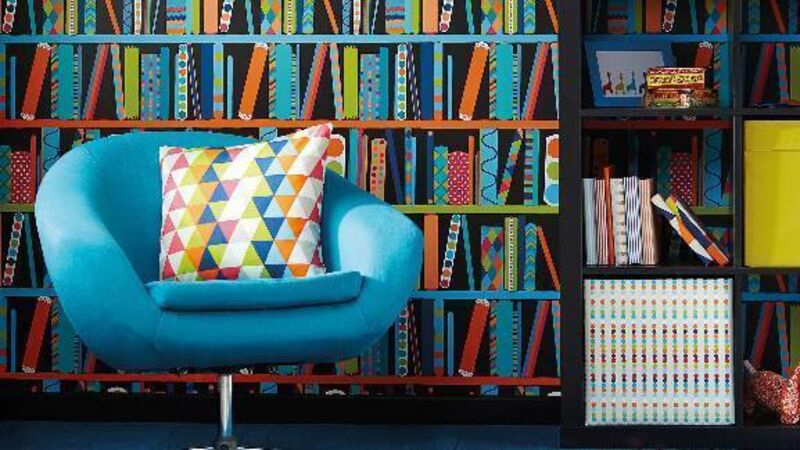Some really cool colour combinations

Let’s look at three, successful designer imaginings and consider why they work and how you could apply these lessons at home.
Reds and forest-greens have held sway in dining rooms for centuries, a meaty, decadent red being said to stir the appetite. In a period-inspired surrounding, (see room set by Colortrend right), and set against white wood work, the architectural elements of the room are brought into sharp relief with a gorgeous, dining-room red. It’s not a large room and adjuncts a much brighter, two-storey hallway.
However, with the ceiling and plaster-work left white (Colortrend ‘Almost White’) and pale carpeting amplifying light, the dining room seems baronial in these Etruscan robes.
The dogged belief that pokey, problematic rooms cannot take dark colours strangles a more creative approach. Deeper shades have their own talents. Instead of visually massaging the room’s dimensions with pale colour, (on a working level, that’s down to furnishings and storage), dramatise it as warm and enveloping.
Strangely, the very deepest shades of grey, charcoal, navy blues, and chocolate browns sit with a quiet, determined character in pinched spaces where livelier, saturated colours, such as those used here, need more room to prowl.
Our dining room’s deep ruby is relieved by the absence of one wall leading into that vast, cream hallway. The ratio of walls to doors, glass, curtains and voids in a room may be close, so consider darker paint and paper schemes for available walling, before just leaping into the life raft of comfortable neutrals. For the truly brave — take that wall colour to the floorboards or carpeting, blurring all those disparate boundaries of a wall, a wall, a wall, and then the floor, for the ultimate harmony of one embrace of colour. Belt the dark stranger in white woodwork and leave the ceiling white. Colortrend: €60-€68 for five litres.
Purely practical: If you use a dark colour topcoat of paint, set it over a dark undercoat. This will not only improve the final shade, but will save you three coats over a pale wall. Invest in the best, pigment-rich colour. Use silk where you’re likely to stain the walls, as matt, dark colours are not forgiving of spatters. There’s a cold, advancing blue/red and there’s a chalky, warm red. If there’s one colour you must test at home, in various aspects and lighting conditions, it’s red.
I chose this room-set, by Dulux, because it’s ethereal, with a dreamy, classic beauty for such a radical, contemporary space. The walls seem to be lit from within. Painted white, this room, and its towering mezzanine, could have been cold, dull and daunting, but lifted with a pearly, pewter grey (Dulux Modernism), and, with a lick of lipstick pink, it cleverly recalls the flickering neon of an American 1950s diner. Even the door recesses have been treated to a highlight and the bald strip lights set on end, bring glowing tints to a boring corner. Look how much the right paint has contributed to this area.
Don’t be afraid of adding character, (here with Dulux ‘flamingo fun 4’) when using a pale-grey colour scheme. It’s mid-century modern in spirit, all the rage, and in accents easily changed, if your passion for fashion dims. What might seem like a daring combination of colour, pink and pale grey is a standard marriage taken from any decorator’s colour wheel. Grey is still holding its own as a cooler rival to traditional, warm, creamy neutrals and sits with pops of purple, orange, emerald greens, fizzing yellow, and pinks, effortlessly. Dulux emulsions from €12 per litre.
Purely practical: If you’re planning to add a dash of accent colour to a backdrop, you need to test the volume of each set, close to each other, for appraisal. Try painting an entire mood board with the main colour, leaving a small area for accents or posting separate cards or remnants of material with the colour. Don’t over-paint, as the colour underneath will subtly alter your top testing colour.
Suede paints and colour washes may have fallen out of favour, but in their stead a new family of hyper-realistic and witty, illustrated wallpapers have stepped up. Clarke & Clarke’s ‘peeling plank’, here in mineral, can be placed horizontally or vertically. Resolution quality, using digital imagery, has become so convincing and three-dimensional that you could almost sand off the paint flakes. Drenched in character, in the soft northern light of a bathroom, the paper plays with faded gentility, the soft vintage robes adding to a comfortable, washed-out loveliness. It’s presented as a big illustration, not pretend planking, and you can find bead-board, bricks, scrap wood and concrete slabs to just paste up. Peeling plank: €54 per roll. Wallpaper Direct.
In ‘all about me’, from Harlequin, this book paper is bold, graphic, close to a cartoon, and likely best confined to one wall. Alcoves, a boring study, or student nook can all take this heat, and lift a colour from the paper for accessories, here seen in the chair, lamp, and open bookcase. The book theme is everywhere and you can have a more monochrome, print-room edition if you prefer. €50, harlequin.uk.com.
Purely Practical: The more determinedly ‘picture like’ a wallpaper, especially in bold colours, the quicker you are likely to tire of it. Choose a paste-the-wall product over a conventional paste-the-paper and you can peel it off easily. Take note of the repeat, as this will demand more paper than merely measuring out the walls. The larger and more random the motifs, the greater the repeat. Giant wall decals from suppliers, including Digitexhome.co.uk, Wallstickers.ie and Allposters.ie, combine use of a rear-wall colour with a giant transfer you can tear off at will, from about €20.
* With thanks to Colortrend, www.colortrend.ie, Dulux, www.dulux.ie, Clarke & Clarke, www.clarke-clarke.co.uk, and Harlequin, www.harlequin.uk.com.












